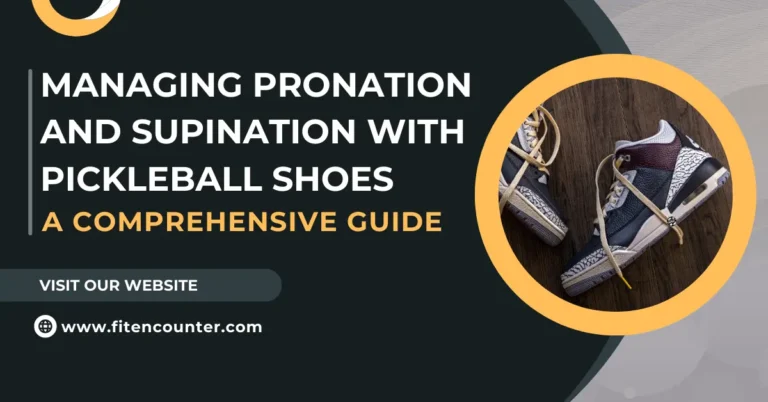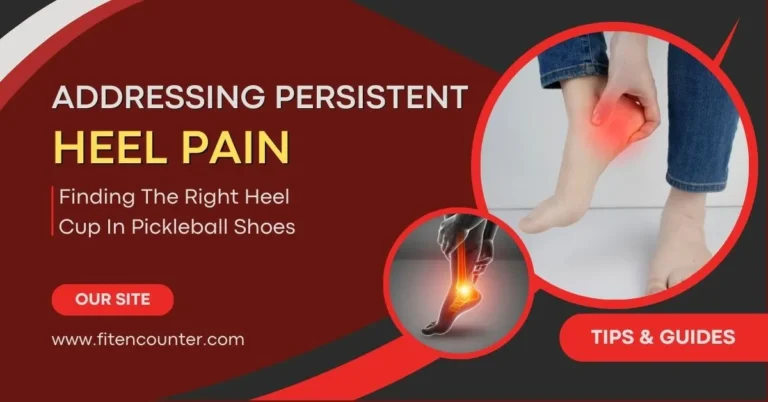How to Choose a Pickleball Paddle? Choose the Right Paddle
Pickleball players often need guidance when getting a Paddle for their game. There are so many options to choose from, and you just don’t know which will suit you the best. The thing is, there is no “perfect paddle” for every player. They are all perfect, just not for the same person.
You need to keep certain things in mind when getting your new Paddle. You need to know what to look for in a Pickleball Paddle. These properties include Grip, Weight, Material, Shape, and Price.
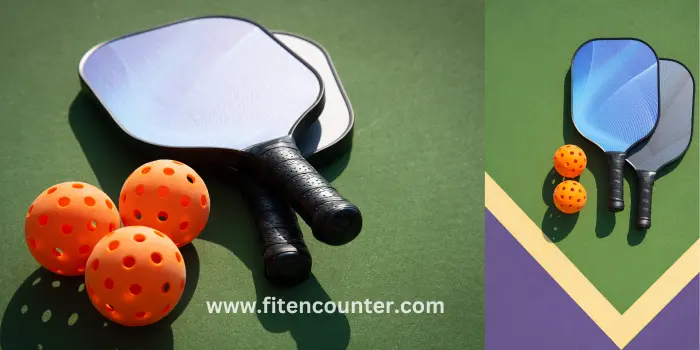
Again, there is no ideal paddle for everyone; the choice is subjective. Everyone has their own needs, and there is a paddle for everyone out there.
In this guide, I will explain all the requirements of the Pickleball Paddles and which is best for you based on those characteristics. I will also provide a detailed analysis of the prices of these Paddles so you can make the best choice for yourself in terms of budget. Let’s get started.
5 Things to Consider While Choosing a Pickleball Paddle
1. Choose the Paddle Grip that Suits You
The grip is an important thing when choosing your Paddle. Many players reportedly underperform in matches only because their Paddle grip isn’t good enough for them. You must ensure your hand lays strong on that paddle for the most effective shots.
For that, you need to know what size of Pickleball Paddle you need. You need to find your grip by following a method: Use a ruler to measure the distance from the tip of your ring finger to the middle crease of your palm. This measurement reveals your ideal grip size.
If the measurement is 4.5 inches, you need a 4.5-inch grip. If you are unable to measure your hand’s length, you can use your height as an alternative guide:
- Under 5’2”: 4” Grip
- 5’3” to 5’8”: 4 1/8” to 4 1/4” Grip
- 5’9” and taller: 4 1/2” Grip
You should also check your natural grip to see if it fits the paddle. Here’s how: Grab the paddle naturally. Slide your index finger between your fingers and the heel of your grip hand. A good fit allows your finger to fit securely without moving other fingers.
Overgrips are also a thing. They are cover on the racket, allowing you to customize the grip’s circumference. They absorb sweat and improve comfort. You should consider adding an overgrip for a personalized touch.
Pickleball paddles come with various grip materials. High-end paddles may also have premium grips for added comfort and sweat absorption. If your grip starts to wear out, you can replace it with a new premium grip to level up your game.
Tennis players switching to pickleball might prefer grips shaped like tennis racket handles. This allows for familiar wrist action. Some grips cater to particular play patterns, like more extended grips for a tennis-like feel.
2. Get Comfortable With Paddle Weight
One of the primary aspects of Pickleball that customers need to keep in mind is how heavy or light the Paddle is. You need to find a perfect balance in the weight to make swings easily and effectively. Be mindful that the ideal weight for anyone is subjective. There is no single perfect weight for everyone.
The Pickleball Paddle weight matters because it impacts your swing, control, and power. Lighter paddles are easier to move, while heavier ones can add extra energy to your shots.
Paddle weights fall into 3 categories:
- Lightweight (under 7.3 oz). Easy to maneuver, great for precise shots.
- Mid-weight (7.3 to 8.4 oz). A balance of maneuverability and power.
- Heavy (8.5 oz and over). Offers more power but might be slower to swing.
Consider your playing style while choosing a paddle weight. If you want quick and precise shots, a lighter paddle will suit you. For players needing extra energy, a heavier paddle is preferred.
Many players wonder what is the ideal weight for a Pickleball Paddle. It entirely depends on you. But understanding the basics can help you make a decision. If uncertain, try different weights to see what feels best for you.
To make it even simpler, check out this table to understand the characteristics of the 3 classes of Paddle weights:
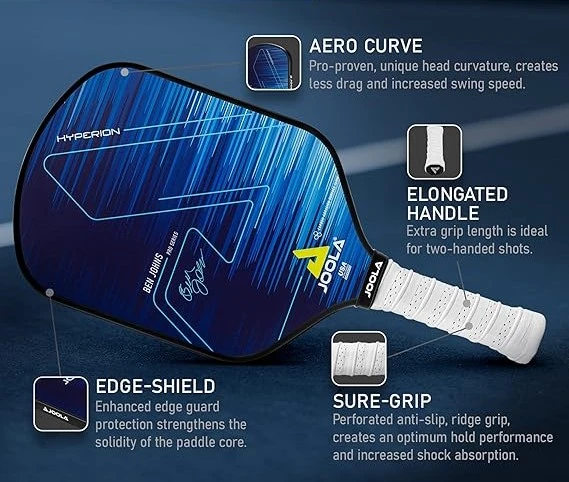
| Weight Range | Characteristics | Suitable For |
| Lightweight | Easy to maneuver, great for precision shots | Quick players |
| Mid-weight | Balance of maneuverability and power | Versatile players |
| Heavy | Offers more power but might be slower to swing | Power-focused players |
Remember, the right weight contributes to your playing style. Take your time, try these weights, and find the one that feels right for you!
3. Choose the Paddle Material Best For You
It makes a massive difference in the Pickleball Paddle material. Different materials have different properties, and you, as a customer, should know their characteristics before purchasing these paddles. Let’s review all the available materials for the Pickleball Paddles and their characteristics:
Wooden Paddles
Graphite Paddles
Composite Paddles
Aluminum Core
Nomex Honeycomb Core
Polymer (Poly) Core
4. Pick the Best Paddle Shape
The shape of the pickleball paddles plays a crucial role in your game experience. This, like others, is also subjective. Some players prefer one shape; others prefer the other. Let’s go over all 4 shapes:
Edgeless Pickleball Paddles
First, we have the edgeless pickleball paddles, which skip the protective guard along the edges. Serious players often choose this as they maximize the playing floor, albeit with a bit of vulnerability to impact without the guard.
Wide Body Paddles
Then there are the wide-body paddles, the most common form in pickleball. With a width of about 8 inches and a length of 15 ¾ inches, those paddles comply with official regulations and provide players with a balanced and classic feel. They are a famous choice for folks who admire a standard and reliable playing experience.
Oversized Paddles
Moving over to oversized paddles, manufacturers tweak the dimensions by adding length to the face and shortening the handle length. This adjustment maintains the entire length inside the rules while offering players extra reach, catering to specific preferences in playstyle.
Elongated Pickleball Paddles
Lastly, the elongated pickleball paddles have emerged as a newer class. With an extended length of up to 17 inches, these paddles reduce the face width, resulting in a narrower sweet spot. While this might challenge less experienced players, those with extra skill often appreciate elongated paddles’ added reach and unique characteristics.
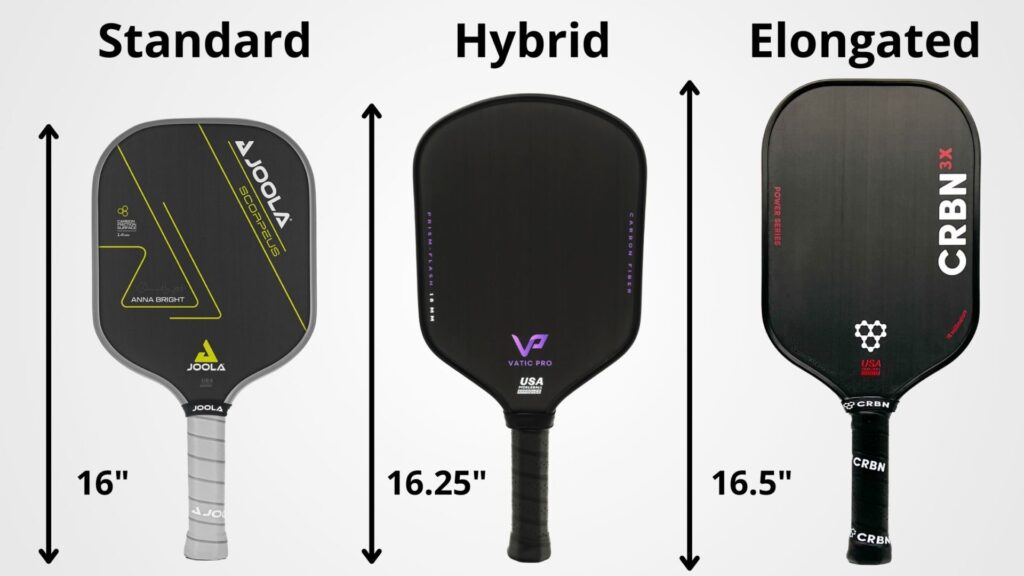
5. Consider Paddle Noise Management
Playing pickleball is becoming super popular, but sometimes too much noise can be a problem, mainly in places with many courts. Some communities are becoming critical about this and have guidelines about which paddles you can use to keep environments calm and happy.
The sound your paddle makes comes from what it is made from and how it is assembled. Materials like Polymer are known to keep things quieter, making the game more enjoyable for everyone. It’s like making sure the instruments in a band are just right for a great sound. Also, check the Paddleball Vs. Pickleball.
If you’re playing where there are noise-related policies, it’s a good idea to pick out a paddle that follows the guidelines. Many paddles now have a unique mark that says they’re suitable for keeping the noise low while hitting the ball. Make sure you know what paddles are allowed by checking a list or speaking to other players who know the court rules.
Using a paddle that doesn’t make excessive noise follows the rules and makes the sport more fun for everyone.
Price vs. Performance in Paddles
There are different tiers of Paddles that vary based on their prices. If you want the best Paddles, you have to spend more. While average and regular Paddles may underperform, they are underpriced too. Let’s go over the price ranges of these Paddles and their properties:
Some shops offer demo days, letting you try paddles before deciding. If you get this opportunity, always make use of it.
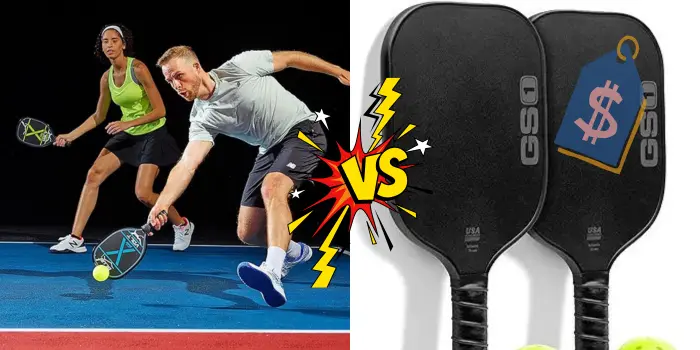
FAQs
What makes pickleball paddles cost more or less?
The price of paddles depends on what they are made of and the brand. Fancy materials and well-known or luxurious brands make them pricier.
Can I get a good pickleball paddle for a small price?
Yes, you could! Look for paddles that don’t belong to a super-high-class brand and have regular material. Superior quality materials cost a lot more. Sometimes, shopping for sets with more than one paddle can save you money.
Is it okay for a beginner to use an expensive paddle?
It’s better to begin with a less pricey paddle as a beginner. Later, as you get better at the game, you can get higher-class paddles if needed.
How do I know if I need a light or heavy paddle?
Light paddles are smooth to move, and heavy ones hit tougher. Choose based on what feels good for the way you want to play.
Should I only pick paddles from famous brands?
Famous brands are good but not always the perfect choice. Think about your budget and what you like. Check reviews and try some paddles to see what works best for you.
How do I determine the right grip size for my pickleball paddle?
To determine the correct grip size, measure the distance from the middle crease in your palm to the tip of your ring finger. This measurement should guide you in choosing the appropriate grip size.
Conclusion
All in all, all that matters is, “What paddle suits you perfectly?” If you figure that out, you’re halfway there. There is a big difference between those who are comfortable with their Paddles and those who aren’t.
Here is a quick summary of the different Pickleball characteristics discussed in this article:
- Buy a pickleball paddle that feels good for you. Light ones are easier to move, while heavier ones pack more power.
- Get a paddle with a handle that fits your hand just right. Smaller handles let you spin the ball, and bigger ones give stability.
- Know what your paddle is made of wood, graphite, or composite. Each one plays a bit differently.
- Pick a paddle shape that fits your style: no edges for more space, a regular size for the rules, or a longer one for exceptional reach.
- Have fun with paddle colors! Choose one you like or think might help in the game.
- Consider how much noise your paddle makes, especially if it bothers others. Quieter paddles are suitable for peaceful games.
- Find a paddle that fits your game without spending too much. You can get a good one without breaking the bank.
Remember, your pickleball paddle is your game buddy. Pick one that makes you happy on the court!



